
Chevrotin is a soft goat milk based cheese produced in the historical region of Savoy, (France). Since 2002 it has had an AOC designation. [1]

Chevrotin is a soft goat milk based cheese produced in the historical region of Savoy, (France). Since 2002 it has had an AOC designation. [1]
Chevrotin has been produced since the 17th century in the Alpine foothills of the Savoyard Chablais, Bauges and Aravis districts. The landscape presents difficulties to agriculture, with steep gradients, a damp climate and a thin limestone-based soil that supports a restricted vegetation. The only domesticated animals that can feed here are goats that are able to move around with the same sure-footedness as the chamois who live nearer the mountain peaks. Chevrotin is made from filtered but unpasteurised goat milk. In order to produce cheese meeting the AOC criteria, the milk must be produced by a herd of 80% alpine breed goats. [2]
The cheese is a fresh cheese with only a brief maturation period. Production tends to be a small-scale artisanal process. At a minimum, it needs three weeks to ripen. This takes place on pine timber shelves, and during ripening time each cheese is turned and washed with brine three times per week. [2] Chevrotin received the Appellation d'Origine Contrôlée (AOC) and protected designation of origin (AOP) in 2002.
The cheese takes the form of a flattened cylinder, with a diameter of 9 – 12 cm and a thickness of 3 – 4½ cm. It generally weighs 250 - 350 g. Chevrotin features a thin coating of soft reddish-brown, not unlike the rind of such better known cheeses as Munster. Chevrotin appears similar to Reblochon which is made in the same regions of Savoy, applying similar processes, but which is produced lower down the valleys using cow's milk.
The cheese has a full flavor with an aromatic sourness reminiscent of the wild herbs included in the spring and summer diets of the mountain goats. Chevrotin can be eaten with bread at breakfast, or as part of a cheese-board at the end of a main meal. The best season during which to eat chevrotin is generally between May and September, approximately five weeks after manufacture, but it can be enjoyed any time between April and November. [3]
During the winter months, the goats are housed in sheds and their diet of hay does not produce the subtle herb based flavor for which enthusiasts value chevrotin.[ citation needed ]

Gruyère is a hard Swiss cheese that originated in the cantons of Fribourg, Vaud, Neuchâtel, Jura, and Berne in Switzerland. It is named after the town of Gruyères in Fribourg. In 2001, Gruyère gained the appellation d'origine contrôlée (AOC), which became the appellation d'origine protégée (AOP) as of 2013.

Brie is a soft cow's-milk cheese named after Brie, the French region from which it originated. It is pale in colour with a slight greyish tinge under a rind of white mould. The rind is typically eaten, with its flavour depending largely upon the ingredients used and its manufacturing environment. It is similar to Camembert, which is native to a different region of France. Brie typically contains between 60% and 75% butterfat, slightly higher than Camembert.

Roquefort is a sheep milk blue cheese from southern France. Though similar cheeses are produced elsewhere, EU law dictates that only those cheeses aged in the natural Combalou caves of Roquefort-sur-Soulzon may bear the name Roquefort, as it is a recognised geographical indication, and has a protected designation of origin.
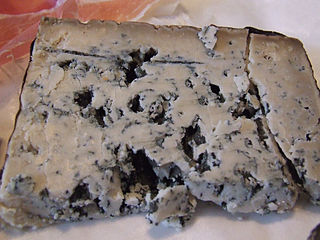
Cabrales is a blue cheese made in the artisan tradition by rural dairy farmers in Asturias, Spain. This cheese can be made from pure, unpasteurized cow’s milk or blended in the traditional manner with goat and/or sheep milk, which lends the cheese a stronger, spicier flavor.

Goat cheese, goat's cheese or chèvre is cheese made from goat's milk. Goats were among the first animals to be domesticated for producing food. Goat cheese is made around the world with a variety of recipes, giving many different styles of cheeses, from fresh and soft to aged and hard.

Camembert is a moist, soft, creamy, surface-ripened cow's milk cheese. It was first made in the late 18th century in Camembert, Normandy, in northwest France. It is sometimes compared in look, taste and texture to brie cheese, albeit with a slightly lower butterfat content than brie's typical 20% – 25% by weight.
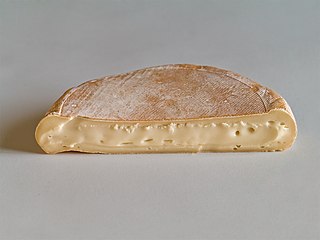
Reblochon is a soft washed-rind and smear-ripened French cheese made in the Alpine region of Haute-Savoie from raw cow's milk. It has its own AOC designation.

Munster, Munster-géromé, or (Alsatian) Minschterkaas, is a soft cheese with a strong taste and aroma, made mainly from milk first produced in the Vosges, between the Alsace-Lorraine and Franche-Comté regions in France. The name "Munster" is derived from the Alsace town of Munster, where, among Vosgian abbeys and monasteries, the cheese was conserved and matured in monks' cellars.
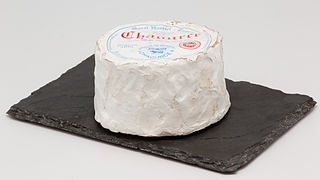
Chaource is a French cheese, originally manufactured in the village of Chaource in the Champagne-Ardenne region.

Cantal cheese is an uncooked firm cheese produced in the Auvergne region of central France: more particularly in the département of Cantal as well as in certain adjoining districts. Cantal cheese was granted Appellation d'Origine Contrôlée certification in 1956. One of the oldest cheeses in France, Cantal dates back to the times of the Gauls. It came to prominence when Marshal Henri de La Ferté-Senneterre served it at the table of Louis XIV of France. Senneterre is also responsible for the introduction of Saint-Nectaire and Salers.

Roussette de Savoie is an Appellation d'Origine Contrôlée (AOC) for white wine in the Savoy wine region of France. The AOC covers much of the Western part of the Savoie AOC for wines made at least in part from the regional grape variety known as Altesse, also called Roussette. Roussette de Savoie is the second-largest appellation in Savoie and is responsible for approximately 10% of the region's production.

Rocamadour is a French cheese from the southwest part of the country. It is produced in the regions of Périgord and Quercy and takes its name from the village of Rocamadour in the département of the Lot.

Chabichou is a traditional semi-soft, unpasteurized, natural-rind French goat cheese with a firm and creamy texture. Chabichou is formed in a cylindrical shape which is called a "bonde", per the shape of the bunghole of a wine barrel. and is aged for 10 to 20 days. It is the only goat cheese that is soft ripened allowed by Protected Designation of Origin regulations to be produced using pasteurized milk. Chabichou is very white and smooth, and flexible to the palate, with a fine caprine odor.

There are many different types of cheese, which can be grouped or classified according to criteria such as: length of fermentation, texture, production method, fat content, animal source of the milk, and country or region of origin. These criteria may be used either singly or in combination, with no method used universally. The most common traditional categorization is based on moisture content, which is then further narrowed down by fat content and curing or ripening methods.
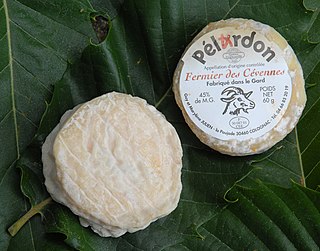
Pélardon, formerly called paraldon, pélardou and also péraudou, is a French cheese from the Cévennes range of the Languedoc-Roussillon region. It is a traditional cheese made from goat's milk. It is round soft-ripened cheese covered in a white mold weighing approximately 60 grams, with a diameter of 60–70 mm and a height of 22–27 mm. Pélardon has benefited from Appellation d'origine contrôlée (AOC) status since August 2000.
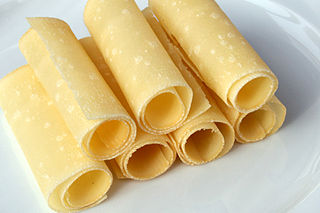
Berner Alpkäse is a hard cheese produced in the Alps of the Bernese Oberland and adjacent areas of Switzerland. It is classified as a Swiss-type or Alpine cheese, and is a spicy, full-fat, raw milk cheese without holes. The cheese is manufactured exclusively with manual labour, usually on a wood fire. An extra-hard variety of Berner Alpkäse, known as Berner Hobelkäse, is aged for at least two years and it is this variety that is most widely available. Both Berner Alpkäse and Berner Hobelkäse are certified as AOPs in Switzerland.